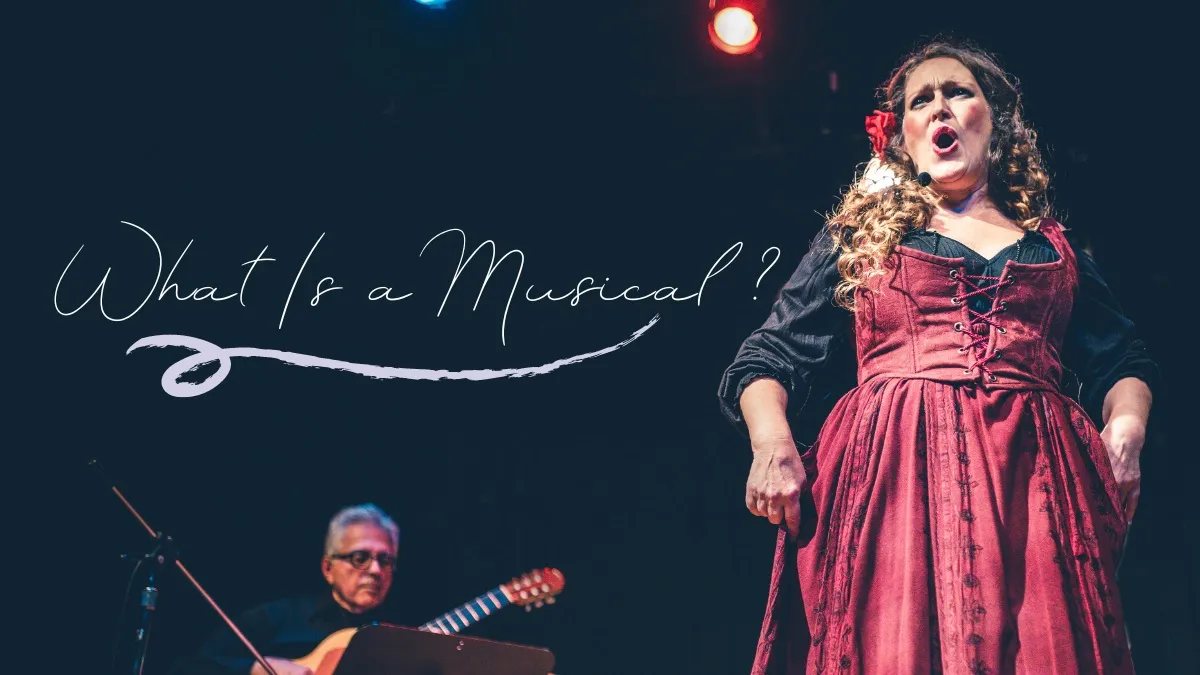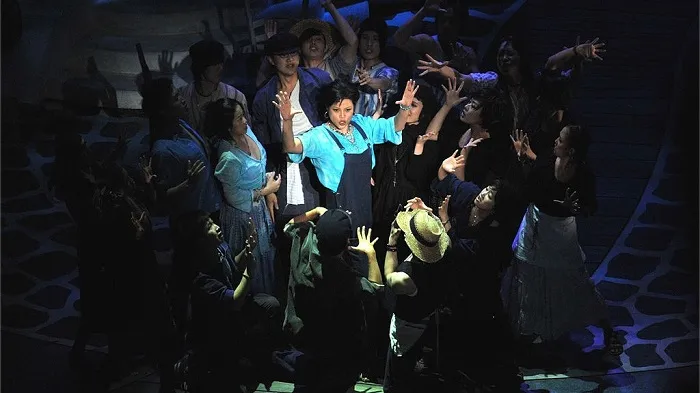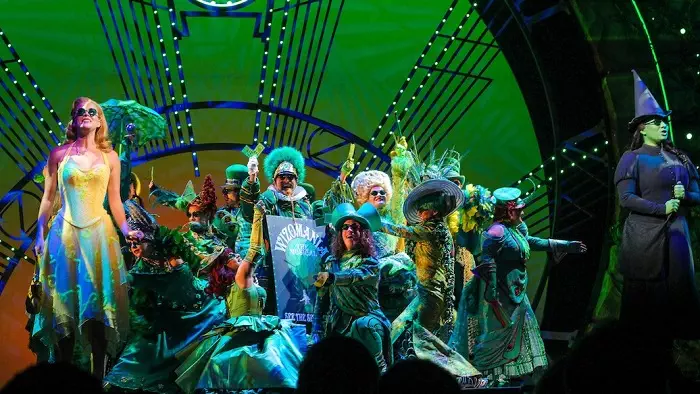Let me imagine how you got to this article: you were having a movie night with your group, and your dreamy, romantic friend chose La La Land for the night. You watched the movie, enjoyed Ryan Gosling’s chemistry with Emma Stone, but you started wondering about musicals.
Have musicals always been like that? Some acting, dancing, and new songs? Or better yet, what is a musical in the first place?
In the modern era, our idea of musicals is mainly based on movies, such as Mamma Mia, La La Land, and maybe Les Miserables. That’s why a lot of people may not be familiar with the concept or origins of such acts.
Well, to cut it short, here’s everything you need to know about musicals.
What Is a Musical?
In the simplest way possible, a musical is a play or movie consisting of both singing and acting. Sometimes, dancing is also included among the main elements.
The concept of musicals got inspired by opera comiques, which are of a French origin. However, some theories also indicate that it got inspired by operettas, which have the same primary elements.
Musicals have no fixed length. Some of them can be as short as single acts, while others may go on for hours with multiple shows.
Generally, musical plays consist of two acts, along with a short intermission in between. More often than not, the first act is longer than the second, introducing all the main characters of the play. It’s also common for composers to end the first act with a complicated plot point on a dramatic note.
In the second act, the dramatic conflict is resolved, and the performers may introduce some new songs.
There are multiple types of musical plays, and each one has its own elements.
The Different Types of Musicals
For the average audience, all musicals will consist of the same things—actors doing their roles, some dancing amid dramatic scenes, and some songs here and there. Only experts will know the difference between each type. Here’s an overview of the most common types of musicals.
Film Musical
Film musicals are the simplest forms of musicals—or at least I think so because they’re the closest to the average audience. If someone gives me a choice between watching a revue musical and a film musical on a fun weekend, it doesn’t take a genius to figure out my choice.
Film musicals are movies that have songs and dances as integral elements, along with the main plotline.
There are many renowned film musicals you can take a look at if you want to compare different types of musicals. There’s La La Land, an Academy Award winner starring Ryan Gosling and Emma Stone. There’s also Chicago, starring Catherine Zeta-Jones, and Dreamgirls, starring Jennifer Hudson and Beyonce.
Book Musical
The term book musical may give you the impression that it’s a musical play based on a book. It’s true, a lot of musicals are based on books, but that’s not the accurate definition of a book musical.
A book musical is a play that aims at engaging the viewers in emotions other than laughter. Its goal is to bring up different emotions through dramatic acts. Additionally, a book musical follows specific criteria. For example, it dictates how many songs the story needs, when they should be added to the play, and what other musical elements will be introduced.
It’s like regular plays, except that it’s more book-oriented, and it follows a specific pattern with clear instructions.
In most book musicals, all the songs are presented in the first act. Then, during the second act, some of them are reprised using different lyrics or tempos. The Sound of Music is a perfect example of that.
Jukebox Musical
The jukebox had all the hype before inventions like the radio and television came up. You only had to push one or two coins, press a button, and the jukebox will start chiming the lyrics. So if you were a teenager in the 1950s and you had some time to kill after school, you’d go into any diner and listen to the latest rock and roll track using the jukebox.
Naturally, a lot of musical creations followed the jukebox, seeing the amount of fame it got. From here, jukebox musicals were born.
A jukebox musical is a play that uses already-made songs. Most musicals had pieces created explicitly for them, but jukebox musicals were different.
The composers put together different songs of mostly single artists. Then, they created a story based on the songs, and they had an entire play made out of it.
The most popular jukebox musical remains Mamma Mia—a play created in the 1990s, inspiring its story from ABBA’s famous song.
Revue Musical
If the word revue sounds odd, it’s actually the French equivalent of the word review. When revue musicals arrived in the US, they were still called review musicals. However, the name was changed to the French variant afterward to add a touch of class.
I can’t help but agree on this one. The word revue does seem classier than review, even if they have the same meaning.
Revue musicals are plays that combine a total of four elements: dancing, singing, sketches, and music. A common theme usually connects all the elements.
When these kinds of plays evolved, they were the closest decent thing to burlesque shows. They often displayed visual gags and some circus talents like juggling.
The golden age of revue musicals was between the Great Depression and the early Roaring Twenties. After that, the glow faded before returning once again when the television got more familiar.
Concept Musical
The idea of a concept musical is that it doesn’t have a structured plotline or a narrative. Instead, it revolves around a specific message or theme. Its aim isn’t to entertain the viewers but rather to grow their awareness of a particular topic.
Most concept musicals don’t even tell a story as most musicals do. They also don’t have a linear progression, so you can’t grasp a start or an endpoint most of the time.
These kinds of musicals became popular in the US around the 1960s. Unfortunately, the decade was generally a time of social upheaval, and musicals like The Sound of Music became a source of boredom to the audience.
By that time, musicals were all repetitive, and the storylines didn’t change. As a result, the theatres lost their hype, and it didn’t return until musicals took a creative turn.
Difference Between Opera and Musical Theatre
Musical theatres and operas have crossovers on multiple occasions, so it’s only natural for some audiences to get confused. Both can be strikingly similar because a lot of musical plays are, in fact, inspired by opera acts.
For example, Madame Butterfly, which is an opera act composed by Giacomo Puccini, is the inspiration behind Miss Saigon, the well-known musical.
The significant difference between musical theatre and opera is that musical plays have some regular acting, while operas consist of only sung dialogues, called librettos.
Plus, in musical plays, the songs don’t tell the story. Instead, they may be merely commenting or acknowledging the plot. They may also be conveying what a specific character is feeling, but they aren’t parts of the dialogue.
Some songs are even spoken rather than sung. For example, in the famous musical, My Fair Lady, Henry Higgins speaks his songs rather than sing them. In this case, they did that because the actor wasn’t originally a singer, but some other examples do it for the story’s sake.
The Complete History of Musicals
There’s a wide variety of musical types, so there’s no doubt that the history of musicals is as fascinating as their evolution. You‘ll be surprised at this, but musicals actually trace back to Ancient Greece.
You probably never thought of this while watching Mamma Mia or Disney’s Frozen. Here’s the entire history of musicals.
The Origins
It’s believed that musicals became a thing first in Europe, before crossing the borders to the rest of the globe. It traces back to Ancient Greece, where theatre was trendy around the 5th century BCE.
It wasn’t until the European Renaissance era that musical theatre upgraded to include more acts. For example, the commedia dell’arte was born, which is an act that includes clowns improvising popular stories. There was also the opera buffa, which is basically a comical form of opera that displays characters of everyday life.
Around the Tudor period, people created a new festive act called court masque. It’s a form of theatre that includes singing, dancing, and acting, so it’s basically a musical play under a different name.
The 1850s–1880s
Around the 1850s, operettas were the most common form of musical theatre. That’s all thanks to Jacques Offenbach, a French composer who turned operettas into an international form of opera with his works. He wrote more than a hundred operettas in his lifetime, but the most popular one is probably Orpheus in the Underworld.
Meanwhile, at the same time in the US, musical theatre was all about revue musicals. The concept evolved later on into burlesques and vaudevilles, and they even crossed the border to the UK.
Operettas disappeared from England for quite some time, no thanks to the Edwardian musical comedies that had all the hype then. It was only in 1907 that operettas re-emerged in Broadway and London when acts like The Merry Widow became famous.
The Roaring Twenties
The musicals in the Roaring Twenties were mainly inspired by vaudevilles. They only revolved around the dance routine and the songs without giving much thought to the plot. The decade’s theme was lighthearted musicals, so most plays had forgettable stories and instead focused on the music.
Some of the most popular musicals of The Roaring Twenties are Funny Face and Lady, Be Good. The famous singers in this era were Ira Gershwin, Cole Porter, and Irving Berlin.
The 1950s
The 1950s era may just be the most important one in American musical history. By this time, musicals were insanely popular across the whole country, and many works made it to the international markets. My Fair Lady, Guys and Dolls, and The Boy Friend are all examples of the decade’s production.
My Fair Lady, in particular, had huge popularity because it’s an adaptation of Pygmalion by George Bernard Shaw. Julie Andrews and Rex Harrison also starred in it, which contributed more to its popularity.
The movie production entities in Hollywood started paying attention to the success, and directors made almost all successful musicals of this era into movies.
The 2000s
Most major musical productions in the 2000s took the safe route. Meaning they didn’t include new stories or plots. Instead, there were many revivals, such as Hair, Grease, Fiddler on the Roof, South Pacific, and West Side.
There were also some adaptations of already-existing stories, such as Fun Home, The Scarlet Pimpernel, and Wicked.
Over time, Broadway musicals turned into tourist attractions instead of creative outlets. They were either revivals or adaptations. In both cases, the directors created no new plots.
The Main Elements of Musicals
Like any other form of arm, there are some main elements that define musicals. Of course, they may vary according to different types, but they essentially exist in all kinds of musicals. Here’s a roundup of the main elements.
Music and Lyrics
Well, music is obviously the most crucial element of musicals. Musical plays had all kinds of music played, including Irish ballads, ragtime marches, blues, and patriotic jingles.
After the music comes the lyrics, which are also among the main elements of musicals. According to the theme of the musical play, the lyrics can be witty or patriotic. On top of that, some musical plays had offensive lyrics, including minstrel songs and so.
By the time when musical plays got extra popular in the US, Broadway lyrics were treated like some kind of poetry. They included sentiments, catchphrases, and stanzas like any Renaissance Era poem would.
The Plot
At some point, songs were the sole main element of musicals, putting the plot aside and focusing on the music and lyrics. But that quickly changed, and musicals started revolving around the story or the central theme.
Some writers worked on songs first, including Oscar Hammerstein II. He reportedly used to write his songs, then think the lyrics through to come up with a whole plot.
Some other writers, like William S. Gilbert, started with drafts of the story. According to his journals, he wrote everything down in leather notebooks, and he wouldn’t delete or remove anything even if it’s not included in the play.
Generally, the plot themes depended on the eras they were written in. In the Roaring Twenties, the stories were lighthearted and entertaining. By the time of the Great Depression, the themes used in musical plays took a dark turn.
Songs
When musical plays first became popular, songs were their essence. They needed to be catchy enough to grab the audience’s attention, and they were written and composed to match the moves of the dancers. Needless to say, it was a challenging mission.
After a couple of decades, some new types of musicals no longer needed new songs. Instead, they used songs that were already popular; those include jukebox musicals.
By the 1930s, the most critical element of musicals became the theme, situation, or book. Songs no longer had the same importance.
Before that, the plot followed the songs and not the other way around. By the 1940s, all music creators started with the story or the plot, and songs came second.
Directors and Choreographers
As musicals became more complicated and included more elements, it became essential to put someone in the lead of the production. Getting a director was the only way to shape the musical’s concept and design while conveying the right message.
The 1930s were the golden era for musical directors. Some renowned directors like George Abbott and George Kaufman emerged, and they put a new definition for directing musical plays. From that point forward, all musicals required directors.
Other than directors, choreographers also became essential for musical plays. In the end, someone had to design the dances and make sure they’re carried out correctly.
Earlier, choreographers were only called ‘dance directors,’ but they gained more prominence after that. Some renowned choreographers also emerged, including Agnes de Mille and George Balanchine.
Both directors and choreographers are vital for the illustration of the musical play. They guide all visual moments, and they make sure the story is precisely displayed as it should.
Producers
Even with directors, performers, and choreographers, no musical would come to the stage without a producer. All the other members are responsible for creating the ideas, designing the dances, and writing the play. The producer is the only one who can implement these ideas and put them into theory.
How these guys work, they raise money for the play they want to produce. The funds raised should cover the opening night of the show, along with the first few weeks and months to make sure all finances are covered.
So, in short, the investors pay the money, the producer receives it and uses it for the play, and then the profit is distributed.

















